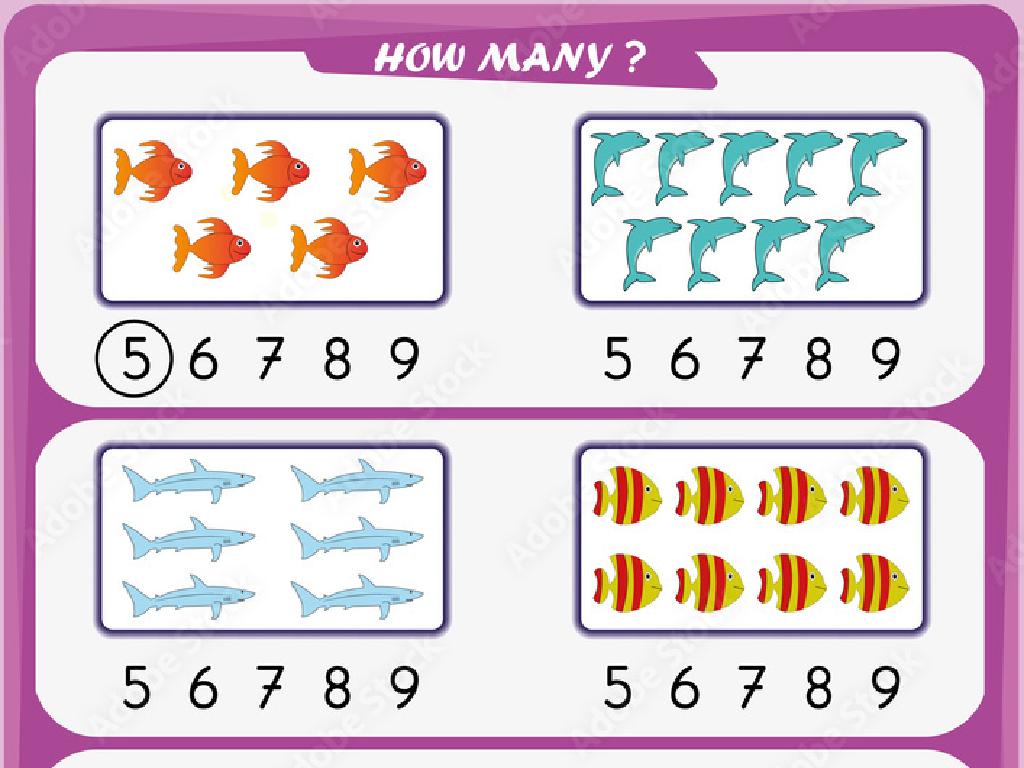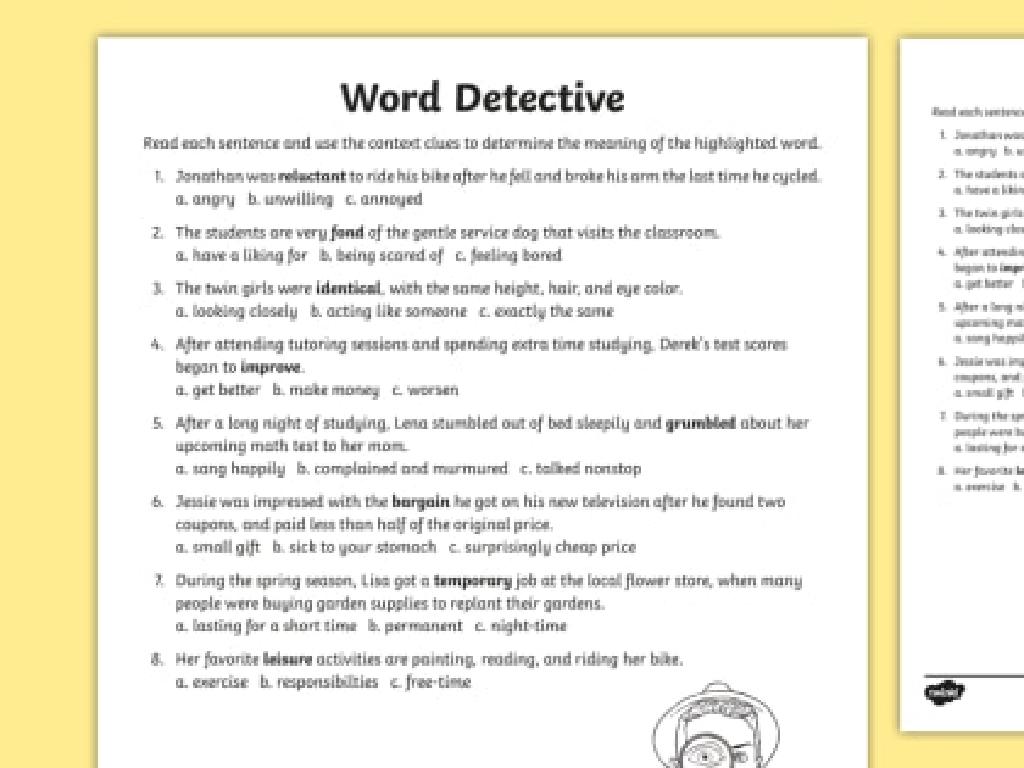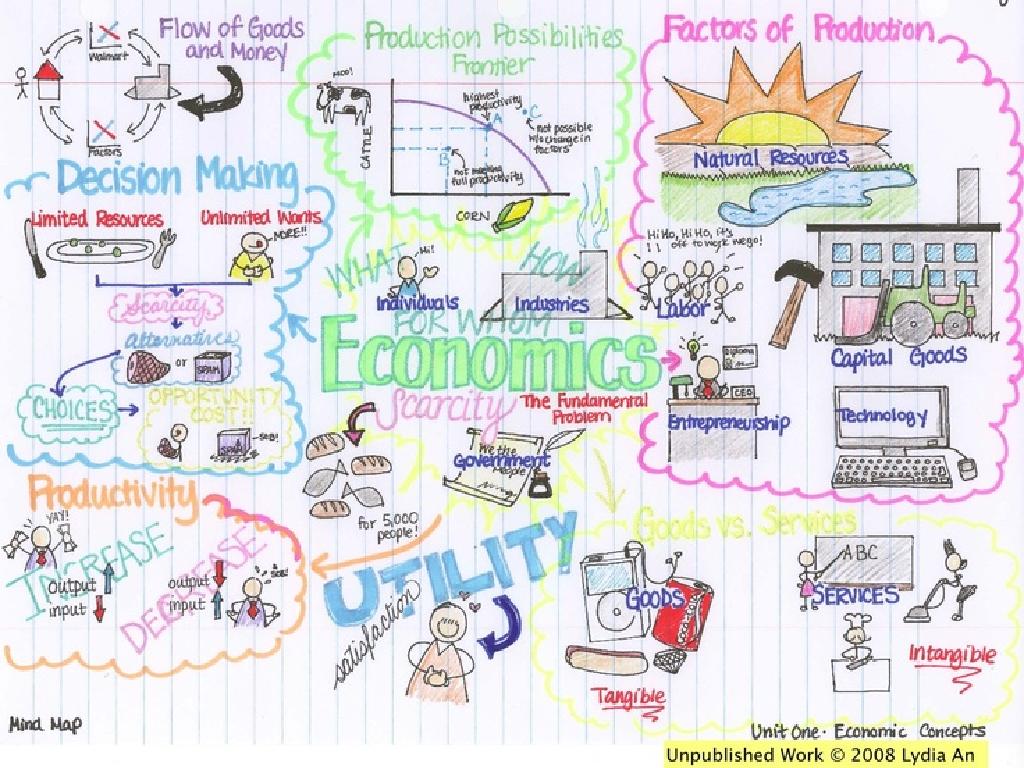Use Personification
Subject: Language arts
Grade: Sixth grade
Topic: Descriptive And Creative Writing
Please LOG IN to download the presentation. Access is available to registered users only.
View More Content
Bringing Language to Life with Personification
– Welcome to Creative Writing!
– Today’s Focus: Personification
– What is Personification?
– Assigning human traits to objects or ideas
– Examples of Personification
– ‘The wind whispered through the trees’, ‘Time marches on’
|
Today’s lesson introduces personification, a key element in descriptive and creative writing that adds depth and emotion to writing. Personification involves giving human characteristics, such as emotions or actions, to non-human entities. This can include objects, animals, or abstract concepts. For example, saying ‘the wind whispered’ gives the wind the human action of whispering, which can create a more vivid and engaging scene. Encourage students to think of their own examples of personification and consider how it can enhance their storytelling. Have them practice by writing sentences that personify an object or idea, and share these with the class to foster a deeper understanding of the concept.
Exploring Personification in Writing
– Define personification
– A figure of speech where non-human things are given human characteristics
– Human traits to non-human things
– Like saying ‘The sun smiled down on us’
– Purpose of using personification
– It helps readers visualize and feel more connected to the writing
– Examples in literature
– ‘The wind whispered through the trees’ shows the wind ‘speaking’ like a person
|
Personification is a key literary device in creative writing that allows students to add depth and emotion to their writing by attributing human qualities to animals, objects, or ideas. This can make descriptions more engaging and relatable. When discussing personification, provide clear examples and encourage students to think of their own. Ask them to consider why an author might choose to personify an element in their story and how it enhances the reader’s experience. Have students practice by writing sentences that personify an everyday object, helping them to see the world from a different, more imaginative perspective.
Personification in Writing
– Wind whispered through trees
– Imagine the wind telling secrets
– Time crawled to vacation
– Feel how slowly time moves
– Sun smiled down on us
– Think of the sun being happy
|
Personification is a literary device where human qualities are given to objects, animals, or ideas. It is used to create more engaging and relatable imagery in writing. In this slide, we explore examples of personification to help students understand how it can bring life to descriptions. The wind whispering through the trees suggests a soft, hushing sound, making the scene more vivid. Time crawling until summer vacation emphasizes the slow passage of time from a student’s perspective. The sun smiling down on us gives a warm, comforting feeling to the sunlight. Encourage students to come up with their own examples of personification and discuss how it affects their imagery and emotional response to the text.
Identifying Personification in Writing
– Spotting personification
– Look for when objects or animals do things people do
– Human qualities in non-humans
– Like a smiling moon or a dancing breeze
– Effect on sentences or stories
– Personification can make descriptions more vivid
– Practice with examples
– Find sentences in a story and explain the personification
|
Personification is a literary device where human traits are given to non-human things. It’s used to create more engaging and relatable imagery in writing. Teach students to identify actions or emotions that are typically human being described in objects or animals, like a ‘whispering wind’ or ‘hungry flames’. Discuss how personification affects the reader’s imagination and understanding of the text. Encourage students to look for examples in their favorite books or poems and explain how the personification enhances the story. This will help them understand the impact of personification on storytelling and descriptive writing.
Crafting Personification in Writing
– Select an object or idea
– Assign human traits to it
– Traits like emotions, desires, or actions
– Compose a personified sentence
– ‘The sun smiled down on us.’
– Enhance descriptions vividly
|
This slide aims to teach students how to use personification in their writing. Personification is a literary device where non-human objects or ideas are given human characteristics. Start by having students choose an inanimate object or abstract idea. Then, guide them to think of human qualities or actions that could logically be attributed to their choice. For example, a clock could ‘run tirelessly’ or ‘stand watch over the room.’ Have them write a sentence that incorporates this figure of speech to add depth and interest to their descriptions. Encourage creativity and the use of vivid imagery to make their writing more engaging.
Practice Time: Personifying Our Classroom
– Let’s practice personification
– Personify classroom objects
– Imagine objects with human traits
– Write your personified sentences
– ‘The chalk danced across the board’
– Share with the class
|
This slide is designed for a class activity to practice personification, which is giving human qualities to non-human things. Encourage students to look around the classroom and choose any object, like a clock, desk, or window. Ask them to think of human actions or emotions that could describe what the object does or seems to do. For example, ‘The clock hands waved at the students,’ or ‘The whiteboard stood proudly displaying the day’s lessons.’ Have students write down their sentences and then share them with the class. This will help them understand personification and enhance their creative writing skills. Possible activities: 1) Pair up students to compare personifications. 2) Create a personification gallery walk. 3) Vote on the most creative sentence. 4) Illustrate their personified objects.
Personification in Literature
– Explore authors’ use of personification
– How do Rowling or Dahl make objects ‘come alive’?
– Impact on storytelling
– Personification adds depth and emotion to stories
– Analyze literary excerpts
– Find sentences where non-humans are given human traits
– Enhance your own writing
|
This slide aims to delve into the concept of personification in literature, a tool that authors like J.K. Rowling and Roald Dahl often use to bring inanimate objects or abstract concepts to life by attributing human qualities to them. Discuss how personification can make stories more engaging and relatable by evoking emotions and creating a vivid image in the reader’s mind. Analyze excerpts from well-known works to identify and understand the use of personification. Encourage students to think about how personification affects their experience as readers and how they might use this literary device in their own writing to enhance their storytelling.
Class Activity: Personify Your Day
– Write a paragraph personifying your day
– Imagine your day as a story character
– Describe its walk, talk, and interactions
– Use creative details and expressions
For example, ‘My day greeted me with a sunny smile, rushing me with a gust of energy.’
|
In this activity, students will practice using personification by writing a short paragraph where they will describe their day as if it were a character. This exercise encourages creativity and helps students understand personification as a literary device. Provide examples of personification, such as describing the day as ‘sunny’ or ‘gloomy’ and attributing human characteristics to it. Encourage students to think about how their day would interact with them if it were a person. Would it be friendly and welcoming, or grumpy and challenging? Possible activities for different students could include personifying a rainy day, a busy day, or a lazy day. This will help them explore various ways to use descriptive language and enhance their creative writing skills.
Sharing Our Personified Stories
– Volunteers present their stories
– Discuss personification examples
– How did objects/elements act like humans?
– Provide peer feedback
– Positive comments and suggestions for improvement
– Reflect on the activity
– What did we learn from this exercise?
|
This slide is for a class activity where students will share the stories they’ve written that include personification. Encourage volunteers to read their stories aloud. After each presentation, lead a discussion on the different ways personification was used, highlighting creativity and variety in the students’ work. Teach students how to give constructive feedback by focusing on what they liked and offering kind suggestions for improvement. Conclude the activity with a reflection session, asking students what they learned about personification and how it enhances descriptive writing. This will help students appreciate the value of literary devices in storytelling.
Conclusion: The Power of Personification
– Recap: Why personify?
– Personification adds depth to writing by giving human traits to non-human things.
– Homework: Craft a story
– Write a short story that includes personification to bring objects or animals to life.
– Use vivid descriptions
– Describe your characters and settings in detail, making them lively and engaging.
– Be creative with personification
– Think outside the box and let your imagination run wild with personification.
|
As we wrap up, remind students of the importance of personification in making their writing more engaging and relatable. For homework, they should write a short story that incorporates personification, which will help them practice this literary device. Encourage them to use detailed descriptions to paint a vivid picture in the reader’s mind and to be as creative as possible in giving human qualities to non-human characters or objects. This exercise will not only reinforce their understanding of personification but also enhance their overall writing skills.





